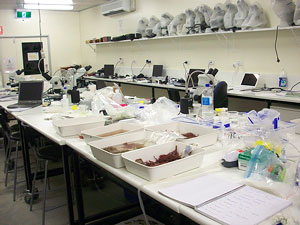

 | |||||||||||
|
|
Journals 2008/2009Zamaria Rocio
August 26, 2008 I did not need an alarm clock to wake up today at 7 am. There was construction going on within meters of our bedroom door. I was rooming with three other women scientists and they all woke complaining about the noise.
It has been just over a year when several buildings at the University of Queensland's research station had burnt down due to an overloaded electrical circuit. We were actually staying in a new dorm facility with a semi-spacious bedroom and bathroom for visiting instructors. In the plans for this research station are an administration building, modern lab rooms, more dorm buildings, and a house for the director. When everything is done, this place will be an amazing facility to bring university students for their field experience. After we ate breakfast, most of our group met to discuss boating and diving. There were only four people not certified to dive here. I was one of them. The divers got their gear together for an afternoon dive. Two boats were going out so the scientist I was working with, Laetitia Plaisance from the Smithsonian Institution, requested a dead coral head from the divers. While they were out diving, the rest of us set up the lab. Boxes had to be opened and the supplies in them placed at the different work areas for the scientists. This took most of the morning and afternoon. Since this was the third Australian CReefs trip, everything was well organized and it went very smoothly. The lab had several kinds of microscopes for our use, and even had Internet access (a necessity on island without a TV or newspaper). After all the divers returned from being out on the reef for over three hours, they informed us that they had not found an appropriate coral head for us. However, they did return with some samples of algae and soft corals for two of the research groups. Both groups took photos of their specimens. The algae group started pressing the ones they could while the others got preserved in jars. The soft coral group took tissue samples of each and preserved everything in 70% ethanol. It was a full day's work!
Yesterday, I asked a couple of questions so here are the answers. |
||||||||||

